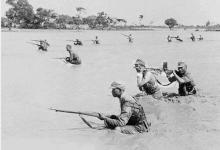The river is prone to flooding. Were flooded in 1593 after years 3000-4000, while the main course has changed 12 times, with at least five large-scale changes from 602 BC to the present. Another source says that more than 1500 floods and course changes 26 (9 large) in 3000 years. These changes, of course, are due to the large amount of loess carried by the river and deposited continuously along the bottom of the river channel. This sedimentation causes a natural dam that accumulate slowly. Finally, the enormous amount of water must find a new way of the sea, causing a flood in a new valley. Flooding was unpredictable, making it difficult for farmers.
Antiquity
Historical maps of spring and during Automne and the Qin Dynasty (221-206 BC), the Yellow River, then flowed north of the current exchange rate. These maps show that the river passes in Luoyang, ran along the border of Shanxi and Henan provinces, then continued along the border of Hebei and Shandong before emptying into Bohai Bay near present-day Tianjin.
The river changed its channel, so flooding 602.Major 11 EC is said to be in September in the autumn of Xin Dynasty (AD 9-23), when the river changed its course, once a north, near Tianjin, south of Shandong Peninsula.
According to Tregear, 10 century BC, a branch was followed by the current price, while a wider scope of the sea near Tianjin, different paths, 602 BC, he moved south of Shantung, AD-70 returned to the present course in 1048 is moved to Tianjin in 1324, he returned to the south of Shantung, and in 1851 took on its present course.
Historical maps of spring and during Automne and the Qin Dynasty (221-206 BC), the Yellow River, then flowed north of the current exchange rate. These maps show that the river passes in Luoyang, ran along the border of Shanxi and Henan provinces, then continued along the border of Hebei and Shandong before emptying into Bohai Bay near present-day Tianjin.
The river changed its channel, so flooding 602.Major 11 EC is said to be in September in the autumn of Xin Dynasty (AD 9-23), when the river changed its course, once a north, near Tianjin, south of Shandong Peninsula.
According to Tregear, 10 century BC, a branch was followed by the current price, while a wider scope of the sea near Tianjin, different paths, 602 BC, he moved south of Shantung, AD-70 returned to the present course in 1048 is moved to Tianjin in 1324, he returned to the south of Shantung, and in 1851 took on its present course.
 The Middle Ages
The Middle AgesA major shift in 1194 took the Huai River drainage system over the next 700 years. Dirt blocked the mouth of the Yellow River, Huai River and thousands homeless. Yellow River on the current path in 1897, when the percentage change last occurred in 1855. Currently, the Yellow River flows in Jinan, capital of Shandong Province, and ends on the Bohai Sea, but the eastern end to stop the Yellow River has ranged from the north and south of Shandong Peninsula, in its many dramatic changes over time.
Changed the course of the river along the path of the Huai River and Yellow River, the original route several times over the past 700 years. Consequently, the accumulation of sediment, which was so heavy that the Huai River flowed to the historic course after the Yellow River returned to its northerly course for the last time in 1897. On the contrary, the pools of water up Hongze lake and then runs south of the Yangtze River.
In flood the river for some of the deadliest natural disasters ever recorded. The flatness of the plain of northern China is contributing to the lethality of flooding. A slight increase in the level of water means that much of the ground is covered with water. When a flood occurs, a portion of the population died by drowning in the first, and then by the spread of disease and famine that followed.
The Yellow River flood of 1887 in the North China Plain has caused 900,000 deaths and 2,000,000.
 Recently
RecentlyThe river gets its yellow color, a vase of fine limestone, mainly comes from the Loess Plateau and transported in the stream. Centuries of sediment deposition and dams has caused the river to flow above the surrounding terrain, making flooding a critically dangerous problem. Flooding of the Yellow River has caused some of the greatest number of deaths in world history, with the 1887 Huang He flood killing 900,000 to 2,000,000 and the 1931 Huang He flood killing an estimated 1 million to 4 million in the plain northern China.
On June 9, 1938, during the Second Sino-Japanese War broke out Nationalist troops under Chiang Kai-shek the levees, which prevent the river near the village of Henan Huayuankou causing what is called a "war caused by a natural disaster. "The purpose of the operation was to stop the advance of Japanese troops by following a strategy of" using water as a substitute for the troops "(Yishui daibing). The flooding of an area covering 54,000 km ² and has taken some 500,000 to 900,000 lives, while an unknown number of Japanese soldiers were killed. The floods have prevented the Japanese army to the city of Zhengzhou, but not prevent them from achieving their goal of capturing Wuhan, the city that served as temporary capital of China at the time.
Another historical source of devastating floods in the collapse of ice dams upstream of Inner Mongolia, with the sudden release of large amounts of water confiscated. There were 11 such major floods of the last century, each causing a huge loss of lives and property. Today, air-dropped explosives used to break the ice dams before they become dangerous.
0 comments:
Post a Comment